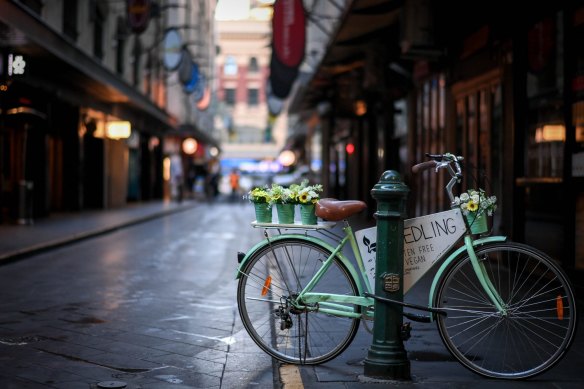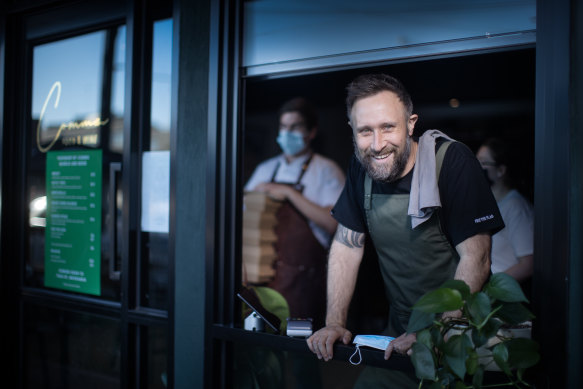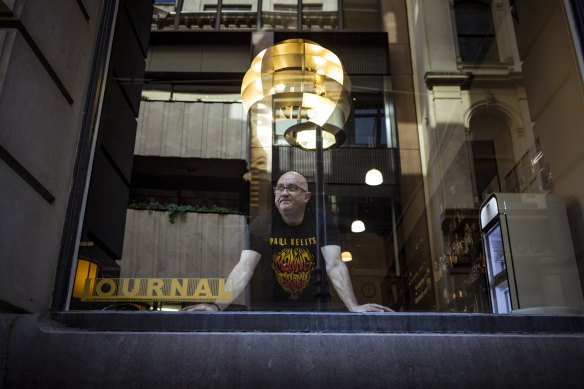This was published 4 years ago
To CBD or not to CBD? COVID’s question for the future of Melbourne
By Royce Millar
Behind the daily discussion of lockdowns, vaccines and quarantine, the pandemic has sparked a quiet but intense battle over the future of Melbourne.
The central city has been hammered, with closed borders, home-working, online shopping and a wariness of public transport, robbing it of the people that made it the engine room of the Victorian economy. Beyond the Hoddle Grid however, COVID-19 has injected new life into long-neglected suburban shopping strips, backstreets and parks.
Local mayors, cafe owners, retailers – and some senior politicians – say COVID has produced what governments Labor and conservative have promised but failed to deliver for 70 years: A city of villages.

An eerie air pervades Melbourne’s empty streets.Credit: Eddie Jim
“This is an opportunity for suburbs to retain their people, grow local jobs and invest and improve the liveability for all of Melbourne,” says Adele Hegedich, mayor of Wyndham in Melbourne’s far west. “The virus has inadvertently, finally, realised the 20-minute neighbourhood.”
The centre-versus-local question is now a serious conundrum for government, business and planners. The state government in particular, is in the hot seat. Big corporate and public investment has been sunk into the CBD, including on mega-projects such as the Metro tunnel, on the assumption of its continuing gravitational pull.
Many, however, are celebrating a sense that for the first time they are able to pull free of it.
From cool to COVID
Melbourne’s post-1980s transformation from insular manufacturing town to global knowledge and services hub made its centre especially susceptible to COVID-19. The hollowed out “doughnut city” of the early 1990s was remade into a cool place to work, eat, drink and play, often within cramped and cosy laneway bars and eateries.
In the years before COVID, the City of Melbourne was Australia’s fastest-growing municipality, the CBD traversed by 1 million workers, shoppers and tourists daily. By 2019 pedestrian congestion was a major concern for the city council.
Now the crowds are gone. After decades of frantic development, construction cranes have thinned on the city skyline. Almost half of Docklands’ streetfront shops are vacant. As The Age reported in October, the central city faces the scar of “bomb sites” left by abandoned or delayed commercial building projects.
Key players in the central city are concerned. In an April letter to Treasurer Tim Pallas, obtained by The Age, the City of Melbourne, the Property Council, the Urban Development Institute, Master Builders Association, Trades Hall Council and CFMMEU, bemoaned the city’s “missing population”.
They warned of an oversupply of apartments and offices and a slump in rental yields, apartment sales and development applications.
The letter calls for measures: a new Postcode 3000, the celebrated 1990s program that promoted the CBD living; government purchase of existing apartments for social housing; a two-year, 100 per cent stamp duty exemption on central city property; and action to get international and domestic students back into the city.
The Spring Street response has been mixed. There is as yet no new Postcode 3000 campaign. But the government is looking to buy properties for social housing in the central city and is pressing the federal government for the return of students. In the May state budget the government announced stamp duty concessions for the City of Melbourne and allocated $107 million to support CBD business recovery.
Treasurer Tim Pallas says the government has targeted COVID support to CBD local businesses “with every hope of seeing our great city thrive again”.
But working from home in particular has sent a shockwave through central Melbourne’s influential commercial property sector.
Foot traffic records for Southern Cross Station for May – before the current lockdown – show an average of just 1300 pedestrians spilling into Collins Street in the morning peak hour, less than half of the 2800 average in 2019. The figures are consistent with both public service and corporate estimates for their own workforces. Only 41 per cent of city workers had returned to their offices according to the Property Council’s April office survey.
In an interview with The Age, Property Council executive director Danni Hunter says an “inevitable tension” has emerged between the pandemic-fuelled localism, and the “viability” of the central city.
“We risk wasting the culture, infrastructure, and benefits of having one of the world’s most liveable cities in our own backyard.”
The local village
Many who live outside the central city see it differently. Steve Staikos, the mayor of Kingston in Melbourne’s south east, recently visited the CBD for the first time in more than a year, since before the first lockdown. “I don’t need to go there anymore – I meet and lobby ministers online now,” he says.
For a young politician and ALP activist for whom political networking is all important, it is a remarkable statement by pre-COVID standards. Staikos says Melbourne changed forever when people discovered they could work at home and shop and play within walking distance.
“I understand (lord mayor) Sally Capp wants to see businesses in the CBD thrive and survive. But I want the same for the businesses and residents of Kingston.”
One of the businesses to open this year in Staikos’ patch is Comma Food and Wine, a restaurant near Moorabbin Station. Comma owners Adam Cruickshank and Megan Kwee live nearby and had pondered the lack of dining options that left locals travelling for a night out.
They took a punt and opened their third suburban eatery. Lockdowns notwithstanding, business is thriving. Working and socialising locally, says Cruickshank, is no passing fad. “We’re now going through a big decentralisation,” he says. “Haven’t town planners been talking about this for a long time?”

Business is booming: Adam Cruikshank from Comma in Moorabbin. Credit: Simon Schluter
Indeed. As early as 1954 the state government envisioned Melbourne as a network of local activity centres that would give residents “many of the facilities of the central city area under more attractive conditions nearer to their homes”.
It was a grand plan thwarted by a lack of political will and influential commercial interests with different priorities.
A city under question
Cities, with their collection of enterprises in a small area, have long been considered a great driver of productivity. Now, however, the economic benefits of workers “agglomerating” in a CBD within a sprawling metropolis like Melbourne, face serious new questions. Research by Swinburne University is soon to be published that will likely query how we calculate the benefits.
Marcus Spiller, principal of prominent consultancy SGS Planning and Economics, says research increasingly indicates a “line-ball” result when the CBD’s strengths are weighed against those of a “polycentric city” – one with multiple activity centres. “It is a pivotal question for the state government in terms of future government job growth,” Spiller said.
Local councils, meanwhile, are stepping up pressure on the state government to decentralise industry and the public service for economic and health reasons. Out west, Wyndham mayor Adele Hegedich notes a “marked increase” in residents using local shops and open spaces. “There’s been a massive increase in pedestrian traffic and cycling.”
Wyndham is working to enhance strip centres and to encourage new retail including cafes and fruit shops. And it is courting big corporates and government: having embraced hybrid home and office working arrangements for its staff, Wyndham now has surplus office space. It is pressing the state government to decentralise and to allow public servants who live locally to “co-locate” in its civic centre.
Hegedich says the CBD has long been a “powerhouse” of the Melbourne economy. “But let’s not have a Kodak moment for Melbourne. Let’s not just go back to the way things were.”
If you’re a CBD trader or Melbourne’s lord mayor, these are challenging words.
Johnny Vakalis is precisely that, a pioneer of the CBD’s post-’80s economic “renaissance” having opened the first cafe in now famed Degraves Street in the mid-1990s. Since 2004 he has fronted the Journal Cafe in Flinders Lane. Everyone in this neighbourhood knows him as Johnny.

Johnny Vakalis, proprietor of Journal Cafe in Flinders Lane.Credit: Chris Hopkins
He says COVID and the longer-term trend to home working have put an end to the CBD’s long boom. Journal will survive, he says, but with a more confined menu, reduced wages bill and no head chef. He expects only about half the cafes in his area to get through the pandemic and its aftermath.
“It’s not going to be the same. The corporates, instead of having three or four floors of offices, they’ll come back to one floor and rotate staff.”
Around the corner lord mayor Sally Capp is surveying locked-down Swanston Street from her Town Hall window. “It’s pretty desolate,” she says by phone in a tone unusual for this upbeat city leader. A former head of the powerful Property Council, she concedes the CBD has been permanently altered by COVID.
“The rhythm of the city has changed fundamentally.” Rather than trying to turn the clock back, says Capp, the council is working with businesses to move to a “new rhythm as quickly as possible”. Yet in some respects the city council is, understandably, clinging to the past.
While the council says 85 per cent of its staff is technologically “enabled” to work from home if necessary, it was pressing to get 100 per cent of them back into the office before the current lockdown.
Capp also says that keeping the tens of thousands of state public servants in the CBD and turning up to their city offices is “absolutely paramount” to recovery. The state’s 25,000 to 30,000 public servants make it the central city’s single biggest employer.
In a letter to Mr Pallas the council, the property lobbies and the unions call on the government to “commit” to central city tenancies and to “defer the policy to decentralise the Victorian Public Service by five years”.
The state’s quandary
The united front of big property interests, employers and unions is a potent one and Pallas is understood to be especially mindful of its message. Neither he nor planning minister Richard Wynne would be interviewed for this article. But there are also strong voices in the state cabinet arguing the economic and political benefits of decentralising to regional centres and suburbs, and allowing public servants to work and spend locally.
The state’s “flexible work policy” announced in March – which encourages, but does not require, public servants to attend their offices three days week – is a compromise, described by acting Premier James Merlino as a balance between supporting the CBD while “ensuring local suburban and regional areas don’t lose the gains they have made from VPS employees working closer to home”.
Former Victorian ALP assistant state secretary turned lobbyist and social researcher Kosmos Samaras, has been surveying public attitudes to the city centre versus local question. He is adamant that Melbourne is in the midst of a big economic reorientation.
“People from all socio-economic backgrounds want to change the way they live and work,” says Samaras. “They don’t want to drive for hours to work if they don’t need to.”
Melburnians, he says, have re-discovered the village. “The health of the local cafe and shopping strip is now an extension of how people feel about their lives and economic viability. The CBD’s going to be looking like it did in the 1980s.”
With what appears to be a permanent slump in commuter numbers, the council is looking to other things that attract people to the city, big cultural events in particular. It saw a clear message in CBD foot traffic numbers when they surged to about 70 per cent of pre-pandemic levels in some places during the Comedy Festival in April, but dropped away again afterwards.
Renewed emphasis is also being placed on bringing “creatives” back into the CBD, most of whom were priced out during the CBD’s pre-COVID boom years.
″Cultural and creative revolutions tend to follow big shocks like this,” says Capp. “We will make the most of this disruption and devastation.”
Meanwhile, out at Moorabbin Adam Cruickshank says he is eager to reopen his new restaurant and once again join the battle for the heart of Melbourne.
“I think it’s going to be bloody interesting for the next decade.”
The Morning Edition newsletter is our guide to the day’s most important and interesting stories, analysis and insights. Sign up here.